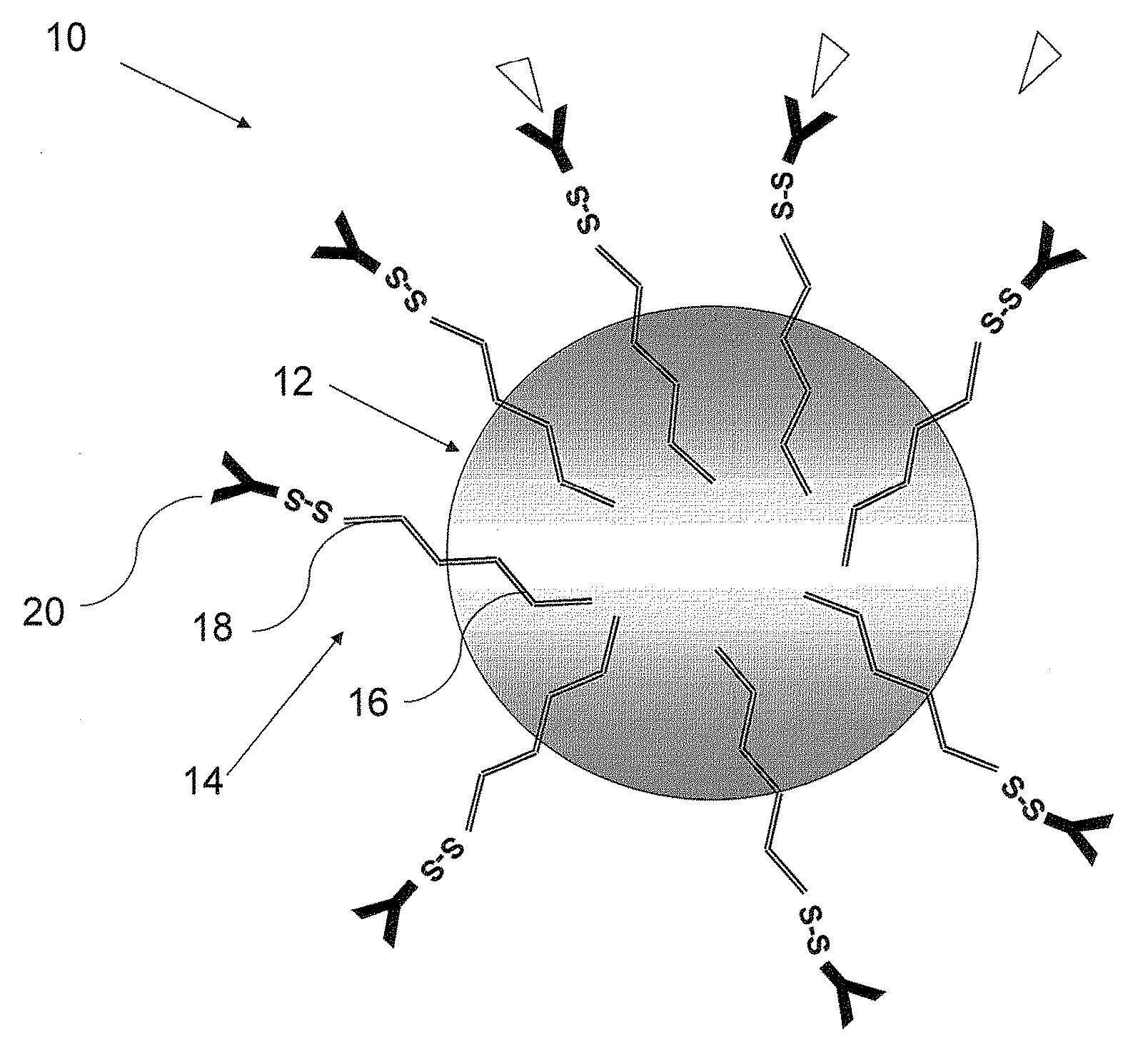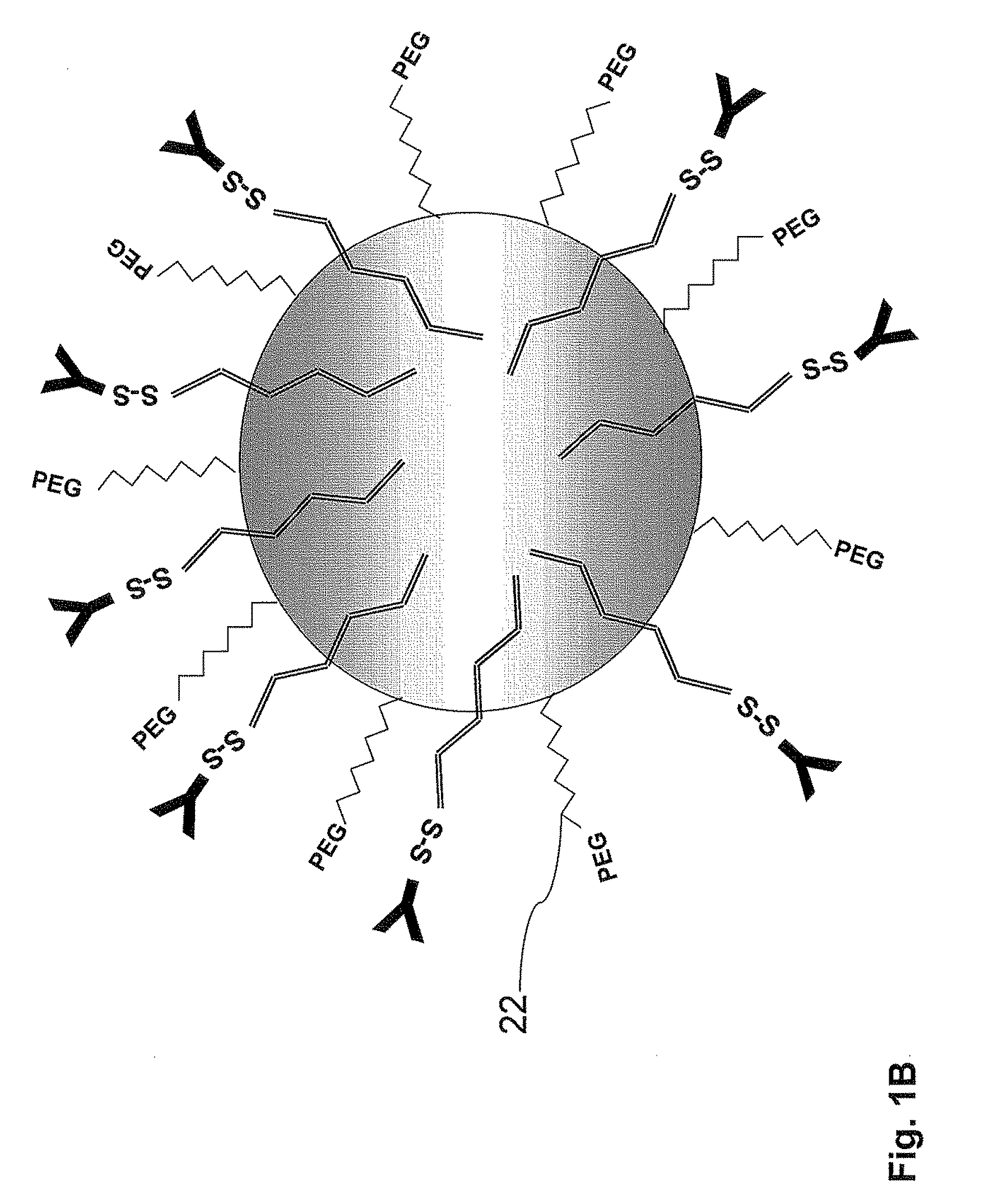Nanoparticles for targeted delivery of active agents to the lung
a technology of nanoparticles and active agents, applied in the field of polymer-based nanoparticles, can solve the problems of reducing the overall bioavailability of pulmonary protein drugs, unable to provide targeting of nps, and reducing the success of pulmonary protein drug delivery, so as to enhance local lung delivery and fast, safe and easy delivery of active agents.
- Summary
- Abstract
- Description
- Claims
- Application Information
AI Technical Summary
Benefits of technology
Problems solved by technology
Method used
Image
Examples
example 1
Cross-Linker (OMCCA) Synthesis
[0169]For the synthesis of Octadecyl-4-(maleimidomethyl)cyclohexane-carboxylic amide (OMCCA), 100 mg of Sulfosuccinimidyl-4-(N-maleimidomethyl)cyclohexane-1-carboxylate (SMCC Pierce, Ill., USA) and 80 mg of stearylamine (SA, Sigma Chemical, MO, USA) were dissolved in 8 ml chloroform and in 41 ul of triethylamine (Reidel-de-Haen, Sigma-Aldrich Chemie GmbH, Steinheim, Germany and the reaction was incubated at 50° C. for 4 hours. The solution was washed three times with 1% HCl and the chloroform was evaporated under reduced pressure. The product was desiccated overnight and weighted. The yield was about 90% and linker formation was confirmed by H-NMR (Mercury VX 300, Varian, Inc., CA, USA), IR (Vector 22, Bruker Optics Inc, MA, USA) and LC-MS (Finnigan LCQDuo, ThermoQuest, NY, USA).
H-NMR, IR and LC-MS Analysis
[0170]H-NMR (of OMCCA in CDCl3): Peaks at: 0.008, 0.849, 0.0893, 1.009, 1.245, 1.450, 1.577, 2.157, 2.160, 2.167, 2.173, 2.178, 2.181, 3.349, 3.372, ...
example 2
Polymers Syntheses
(A) PEG-PLA Synthesis and Characterization
[0173]PEG-PLA (5:20) was synthesized according to well known procedure as described by Bazile D. et al. [Bazile D, et al. J Pharm Sci, 84: 493-498 (1995)]. In brief, 2 g of methoxy polyethylene glycol mw 5000 (Sigma-Aldrich Chemie GmbH, Steinheim, Germany) were mixed with 12 g of D, L-lactide (Purasorb, Purac, Gorinchem The Netherlands) for 2 hours under dried conditions at 135° C.
[0174]The polymer was analyzed by H-NMR (Mercury VX 300, Varian, Inc., CA, USA) and by differential scanning calorimetry (STARe, Mettler Toledo, Ohio, USA).
[0175]Diblock polyethylene glycol (mw 5000) and polylactide (mw 20000) polymer (PEG-PLA 5:20) was synthesized as described above. Gel permeation chromatography (GPC) exhibited mw of 20000 and polydispersity index [PD.I] of 1.47. The polymer was analyzed by H-NMR and by differential scanning calorimetry (DSC).
H-NMR and DSC Analysis
[0176]1H-NMR (of PEG-PLA (5:20)): Peaks at: −0.010, −0.008, −0.00...
example 3
(A) Nanoparticles (NPs) Preparation and Characterization
NP's Preparation
[0183]The PLA nanoparticles were prepare by the nanoparticles—polymer interfacial deposition method as described by Fessi H et al. [Fessi H, et al. Int. J. Pharm. 55: R1-R4 (1989)]. In brief, 88 mg of the polymer PLA (polylactide, 30 KDa purchased from Boehringer Ingelheim) and 38 mg of the co-polymer PEG-PLA, 5:20 (polyethylene glycol of MW of 5000 and polylactide MW of 20,000) were dissolved in 20 ml acetone, a water-miscible organic solvent. To this organic phase 10 mg of the drug docetaxel were added. For coupling of an antibody, to the organic phase, 20 mg of the linker OMCCA were added. The resulting organic phase was then added to 50 ml of aqueous phase which contained 100 mg Solutol® HS 15 (BASF, Ludwigshafen, Germany), as a surfactant (Macrogol 15 hydroxystearate). The dispersion was mixed at 900 rpm over 1 hr and then evaporated under reduced pressure to 20 ml. the NPs were washed with Phosphate Buffer...
PUM
| Property | Measurement | Unit |
|---|---|---|
| Mass | aaaaa | aaaaa |
| Temperature | aaaaa | aaaaa |
| Temperature | aaaaa | aaaaa |
Abstract
Description
Claims
Application Information
 Login to View More
Login to View More - R&D
- Intellectual Property
- Life Sciences
- Materials
- Tech Scout
- Unparalleled Data Quality
- Higher Quality Content
- 60% Fewer Hallucinations
Browse by: Latest US Patents, China's latest patents, Technical Efficacy Thesaurus, Application Domain, Technology Topic, Popular Technical Reports.
© 2025 PatSnap. All rights reserved.Legal|Privacy policy|Modern Slavery Act Transparency Statement|Sitemap|About US| Contact US: help@patsnap.com



